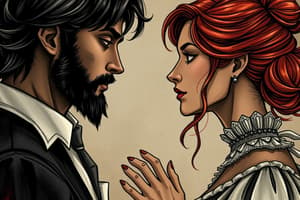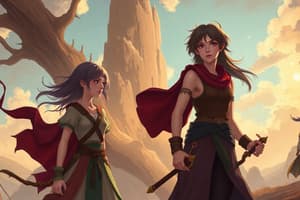Podcast
Questions and Answers
Which character archetype is characterized by a primary antagonist posing the greatest threat?
Which character archetype is characterized by a primary antagonist posing the greatest threat?
- The Big Bad (correct)
- The Overachiever
- The Chaotic Neutral
- The Mentor
What character trait does 'The Tragic Flaw' refer to?
What character trait does 'The Tragic Flaw' refer to?
- A comic relief character
- A beloved character's untimely demise
- A character's weakness leading to their downfall (correct)
- A character's hidden identity
Which character archetype represents a leader who is unaware or ineffective?
Which character archetype represents a leader who is unaware or ineffective?
- The Mad Scientist
- The Tragic Flaw
- The Clueless Leader (correct)
- The Feisty Sidekick
What does 'The Disguised Hero' imply in character archetypes?
What does 'The Disguised Hero' imply in character archetypes?
The 'Plot Twist' is best described as what?
The 'Plot Twist' is best described as what?
Which archetype suggests a character who is perceived as unstable or vengeful?
Which archetype suggests a character who is perceived as unstable or vengeful?
What does 'The Odd Couple' imply in character dynamics?
What does 'The Odd Couple' imply in character dynamics?
Which character is often portrayed with exaggerated intellect combined with superficial traits?
Which character is often portrayed with exaggerated intellect combined with superficial traits?
What term describes a character who initially resists their role as a hero?
What term describes a character who initially resists their role as a hero?
Which character archetype is often utilized to provide comic moments in a story?
Which character archetype is often utilized to provide comic moments in a story?
Which trope describes a character's journey from a disadvantageous position to success?
Which trope describes a character's journey from a disadvantageous position to success?
What is meant by 'The Red Herring' in storytelling?
What is meant by 'The Red Herring' in storytelling?
Which character is typically involved in a romantic entanglement with two others?
Which character is typically involved in a romantic entanglement with two others?
What describes a character who is morally ambiguous, often questioning traditional hero qualities?
What describes a character who is morally ambiguous, often questioning traditional hero qualities?
Which term best describes an object that propels the plot but is not central to the story?
Which term best describes an object that propels the plot but is not central to the story?
What represents a character who returns home after experiencing life away?
What represents a character who returns home after experiencing life away?
Flashcards are hidden until you start studying
Study Notes
Character Archetypes
- The Chosen One: A character identified as having a unique destiny that often leads them to greatness or heroism.
- Final Girl: The sole survivor in a horror film who confronts the antagonist, often embodying resilience.
- The Mentor: An experienced character who provides guidance and wisdom to the protagonist, facilitating their growth.
- The Sidekick: A loyal supporting character who assists and complements the main hero, often adding humor or helpful skills.
Relationship Dynamics and Plot Devices
- The Love Triangle: A romantic dynamic involving three characters, creating tension and conflict.
- The Antihero: A main character with complex and often morally ambiguous traits, challenging traditional definitions of heroism.
- The Loner: A solitary figure who prefers independence, often revealing deep emotional layers.
- The Villain Monologue: A dramatic speech from the antagonist that unveils their plans and motivations, often heightening suspense.
Heroic Themes and Plot Structures
- The Reluctant Hero: A protagonist who initially hesitates or rejects their heroic role but ultimately rises to the occasion.
- The Comic Relief: A character or scenario providing light-hearted moments amidst serious themes, enhancing audience engagement.
- The Red Herring: A misleading or false clue designed to distract the audience from the true plot direction.
- The Rags to Riches: A narrative arc depicting a character's transformation from poverty to wealth and success.
Symbolism and Narrative Elements
- The MacGuffin: An object that drives the plot forward but holds little intrinsic narrative value.
- The Prodigal Son: A character returning home after an absence, often undergoing personal transformation.
- The Femme Fatale: A seductive and dangerous woman who leads characters into perilous situations.
- The Damsel in Distress: A character in need of saving, often reinforcing traditional gender roles.
Identity and Duality
- The Secret Identity: A character concealing their true self, adding complexity to their role in the narrative.
- The Love Interest: The central character around whom romantic feelings orbit, often influencing the protagonist's choices.
- The Buddy Cop: A genre showcasing mismatched law enforcement partners, typically emphasizing comedic contrasts.
- The Underdog: A character at a disadvantage who strives valiantly against odds, embodying resilience.
Character Development and Conflict Resolution
- The Hero’s Journey: A narrative template outlining the hero's adventure, lessons learned, and personal evolution.
- The Double Cross: A betrayal by someone trusted, heightening conflict and revelation within the story.
- The Redemption Arc: A character's journey towards atonement for past mistakes, often involving significant growth.
- The Hidden Depths: Characters with complex inner lives, often revealing unexpected qualities or secrets.
Character Traits and Archetypes
- The Overpowered Hero: A protagonist exhibiting nearly unbeatable abilities, often raising questions about accountability.
- The Jaded Veteran: A battle-hardened character, marked by cynicism or disillusionment from past experiences.
- The Enigmatic Stranger: A mysterious character whose uncertain motives create intrigue and tension.
- The Undercover Agent: An operative infiltrating organizations, often posing moral dilemmas and identity clashes.
Storytelling Techniques
- The Flashback: A narrative device providing background by revisiting past events, adding depth to character motivations.
- The Overachiever: A character who excels beyond realistic expectations, often introducing themes of aspiration.
- The Big Bad: The principal antagonist embodying the central threat, often driving the main conflict.
- The Secret Organization: A hidden group with significant influence, often central to conspiracy narratives.
Character Flaws and Twists
- The Tragic Flaw: A character's inherent weakness that leads to their downfall, adding depth to their narrative arc.
- The Feisty Sidekick: A lively secondary character challenging the protagonist, fostering character growth and humor.
- The Clueless Leader: A leader who is ineffective or oblivious, often leading to humorous or chaotic situations.
- The Mentor’s Death: The loss of a guiding figure triggering significant change or motivation in the protagonist.
Dramatic Turns and Misleading Elements
- The Plot Twist: An unexpected twist that alters the direction of the story, enhancing unpredictability.
- The Fake Out: A deceptive scene misleading the audience, used to create suspense or surprise.
- The Odd Couple: Contrasting characters forming an unlikely bond, highlighting differences and eventual camaraderie.
- The Disguised Hero: A hero operating under a false identity, often leading to unique challenges and revelations.
Miscellaneous Archetypes
- The Chaotic Neutral: A character acting unpredictably without clear moral boundaries, often contributing to disorder.
- The Plot Device: An element serving a specific purpose to advance the story, often at the expense of realism.
- The Incredibly Dense: A character slow to understand obvious circumstances, often providing comic relief.
- The Pseudo-Science: Fictional or exaggerated scientific concepts used to support plot elements.
Lesser-Known Tropes
- The Dark Horse: An underestimated figure or element that gains significant importance as the story unfolds.
- The Crazy Ex: An ex-partner depicted as unstable or seeking revenge, often amplifying conflict in romantic narratives.
- The Brainy Bimbo: An intelligent character presenting superficial traits, challenging stereotypes.
- The In-Law: A family member related to the protagonist by marriage, potentially influencing plot dynamics.
Narrative Complications
- The Amnesia Plot: A storyline centered on a character who loses their memory, raising questions about identity and past.
- The Parental Figure: A character serving as a surrogate parent, supporting the protagonist’s journey and growth.
- The Mad Scientist: A figure engaged in dangerously unorthodox scientific pursuits, often embodying ethical dilemmas.
- The Straight Man: A character who maintains seriousness amidst comedic situations, enhancing humor through contrast.
Cultural Archetypes
- The Noble Savage: A character from a primitive culture representing idealized nature, often contrasted with modern civilization.
- The Sympathetic Villain: An antagonist with a compelling backstory, suggesting complexity beyond typical evil motivations.
Studying That Suits You
Use AI to generate personalized quizzes and flashcards to suit your learning preferences.




